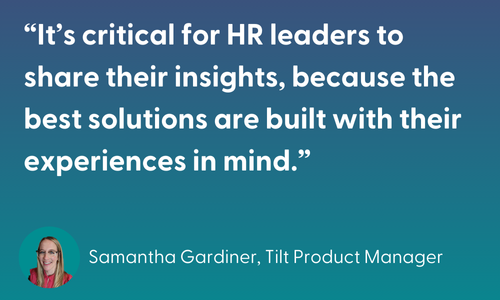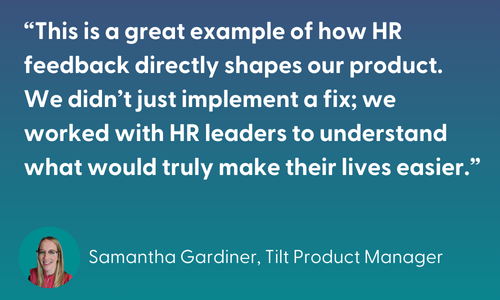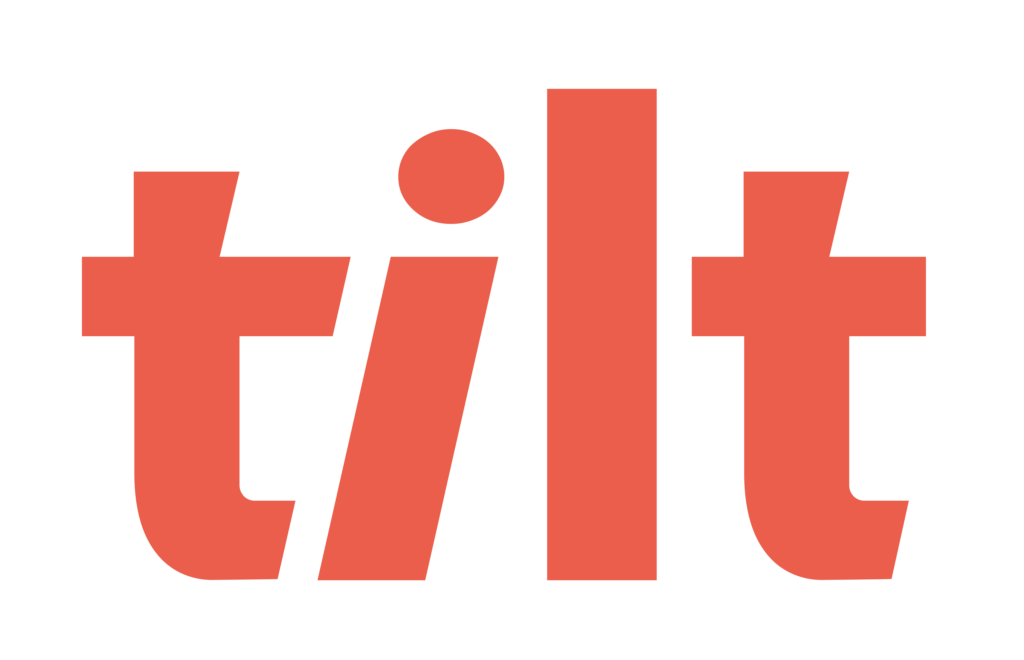They say the best way to predict the future is to create it.
HR leaders are the architects of workplace transformation. Every policy adjustment, every new process, and every technological improvement you champion contributes to shaping a better future for employees.
Nowhere is this more evident than in leave management.
Modern leave software solutions have evolved significantly over the last few years, and that evolution is driven, in large part, by HR professionals who deserve and demand more intuitive, efficient, and supportive systems.
Customer feedback is a crucial driver of innovation in product development, and the best leave software providers actively listen, prioritize, and implement user insights to refine their platforms.
Let’s explore how HR leaders can contribute to shaping leave software, the balance between their requests and a software provider’s long-term product vision, and the critical role customer-facing teams play in delivering meaningful updates.
HR’s Role in Improving Leave of Absence Software
As an HR professional, you live at the intersection of company needs and employee well-being, and the crisscrossing of traffic is getting more hectic by the year.
You are the first to recognize inefficiencies, gaps, and areas where software solutions can better serve your teams. But how do leave management software providers translate your feedback into product innovation?
“I’ve seen firsthand how a lack of transparency and outdated leave management systems can create unnecessary stress for employees and HR teams alike,” says Tilt Product Manager Samantha Gardiner. “That’s why it’s critical for HR leaders to share their insights, because the best solutions are built with their experiences in mind.”

You don’t have to look far beyond real-life experiences to understand the need for improving leave management. If you’re reading this, you’ve likely watched employees struggle through the complexities of disability leave or trying to navigate parental leave PFL states halfway across the country. They’re worried about pay. They’re worried about their livelihood. And they just wish there was an easier way.
These challenges highlight how essential it is for leave management tools to be intuitive, transparent, and truly supportive.
But HR’s voice in shaping software goes beyond personal stories. It’s about structured, data-driven feedback loops that ensure continuous improvement.
How Leave Software Providers Gather and Utilize HR Feedback
A strong leave software provider employs multiple strategies to gather and act on HR insights:
1. Direct HR Feedback and User Interviews
HR professionals provide invaluable insights through direct conversations. These discussions reveal the challenges of managing leave policies, employee communications, and compliance concerns. By engaging in one-on-one conversations, software teams can uncover pain points that might not be visible through data alone.
2. Employee Feedback and Usage Data
While HR professionals are key stakeholders, employees who take leave also provide essential feedback. Their experiences navigating the system, receiving notifications, and submitting documentation help shape a more seamless process. Additionally, software providers track user behavior to identify friction points and areas for enhancement.
3. Customer Success and Leave Success Team Insights
Frontline teams working with HR and employees gather patterns from real-world use. They collect recurring concerns, flag inefficiencies, and relay common requests to the product team. These insights ensure that the most pressing challenges are addressed efficiently.
Balancing User Requests with Long-Term Product Vision
Not all feature requests make it into production immediately, nor should they. “Sometimes, a request seems like a quick fix,” adds Samantha. “But when we dig deeper, we realize there’s a more effective, long-term solution. Our job is to ensure we’re addressing HR’s real problem, not just their surface-level pain point.”
Some feature requests solve an immediate pain point but may not align with the long-term goal of making leave management more seamless and automated. For instance, you might request a manual email notification button for urgent leave of absence cases. While this seems like a quick fix, the underlying issue may be that employees are missing critical notifications. Instead of adding more manual work for HR, the product team may focus on improving notification timing and clarity for the employees needing leave.
The key to great product development is understanding the “problem behind the problem.” HR professionals can help identify these underlying challenges, and a good product team should leverage this insight to create scalable leave solutions that benefit all users.
Case Study: Transforming Leave Notifications
One prime example of this evolution is how Tilt revamped its leave notification system based on HR feedback.
Originally, Tilt sent multiple emails per leave update. While this kept HR teams informed, it also overwhelmed them with information overload. Larger companies with high leave volumes found themselves sorting through dozens of emails each day. HR professionals voiced their frustration, and Tilt listened.
In response, Tilt introduced a daily leave summary email: a consolidated report that provides essential updates in a single, digestible format.
This improvement significantly reduced inbox clutter while still keeping HR teams well-informed.
Moreover, based on continued feedback, the team is now enhancing this feature further by allowing HR teams to customize the frequency and content of these emails. “This is a great example of how HR feedback directly shapes our product,” suggests Samantha. “We didn’t just implement a fix; we worked with HR leaders to understand what would truly make their lives easier.”

Continuous Evolution: The Feedback Loop
Once a new feature is released, the work isn’t over. A strong software provider continuously collects post-launch feedback to assess its impact.
“No release is ever considered ‘final,” says Samantha. “The best products don’t just launch and move on. They evolve. HR teams help us understand how our solutions work in the real world, and we adjust based on what they tell us.”
For example, after rolling out the daily leave summary email mentioned above, some HR leaders requested additional data points be included. Others wanted the ability to opt out of daily emails entirely. These insights guide future updates, ensuring that each enhancement remains aligned with HR’s evolving needs.
The Power HR’s Voice in Leave Software Development
As an HR leader you should have the opportunity to be more than just an end user of leave software. The right provider will give you the ability to be an active participant in shaping its evolution. Your experiences, challenges, and insights can drive meaningful improvements that make leave management more efficient and employee-friendly.
And not just for you, but for every HR manager who has struggled through a pay calculation spreadsheet, tried to learn about new leave laws, dealt with employees who are confused and just need clear and easy guidance in their time of need.
By engaging with leave software providers through feedback sessions, beta testing, and direct communication with customer success teams, you help ensure that the tools you rely on are truly built for your needs.
Does your leave of absence solution give you the power to make real change?
How HR Can Get Involved in Shaping HR Software
Want to have a greater impact on the future of leave software?
Here are a few ways Tilt makes it easy for your voice heard:
- Participate in User Research – Tilt conducts regular interviews and beta tests. Sign up to be part of these programs.
- Leverage Customer Success Teams – Share your experiences and challenges with your Tilt Customer Success Manager. They act as a bridge between HR teams and product teams.
- Provide Data-Backed Feedback – When reporting challenges, share real-world examples and data points to highlight the impact of specific pain points.
- Stay Engaged in Product Updates – Keep an eye on new feature rollouts and provide feedback on their effectiveness. Continuous engagement helps shape future iterations.
HR is Poised to Make a Difference in LOA Software
The best leave of absence management solutions evolve alongside HR needs, fueled by thoughtful, structured, and actionable feedback.
Tilt is dedicated to ensuring HR’s voice is not just heard, but actively shapes the future of leave management. Our platform is built on real-world HR insights, ensuring that every update makes leave management more intuitive, strategic, and impactful.
From simplifying compliance to enhancing the employee experience, we believe that HR should have the tools and support necessary to drive meaningful change.
As an HR leader, your voice is instrumental in driving these innovations. By actively engaging with leave software providers like TIlt, you contribute to a future where leave management is seamless, employee-friendly, and a strategic asset to your organization.
Together, with Tilt, we are not just predicting the future of leave management, we are creating it.
Tilt is leading the charge in all things leave of absence management through easy-to-use tech and human touch. Since 2017, our proprietary platform and Empathy Warriors have been helping customers make leave not suck by eliminating administrative burdens, keeping companies compliant, and providing a truly positive and supportive leave of absence experience for their people.







